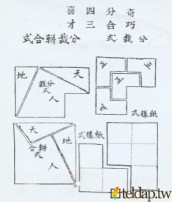|
Divide the Four Delights (奇分四喜) |
|
Like Unite the Three Talents, Divide the Four Delights is a type of manipulative puzzle that falls under the category of assembly puzzles, and it is also recorded in Collections of E Huan Tricks. It is an example of traditional Chinese cut-and-assemble geometric puzzles.
When playing Divide the Four Delights, a player has to divide a piece of paper into four smaller pieces with equal areas. The shape of each piece is the same as the original piece of paper at 1/4 the size. Many toys can be created based on the same principle. The picture depicts one such game that uses four L-shaped blocks. Together they can form a larger L whose area is four times that of each block. By combining the completed puzzle with other puzzles of the same type, players can form even more shapes.
Through arranging and assembling the pieces of Divide the Four Delights, players can:
1. learn about the substitution relation between shapes with equal areas; 2. learn about the fascinating connection between geometry and mathematical ratio; 3. prepare themselves for put-together puzzle (see the note below).
In fact, Divide the Four Delights inspired many variations that departed from the original L-shaped puzzle. Today, the puzzle appears in many different forms. Divide the Four Delights is a kind of close-ended solitary puzzle, so it is mostly played by individuals.
Note:
Assembly puzzles and put-together puzzles are both two-dimensional puzzles, but there are some differences regarding their solutions and rules. For example, assembly puzzles have either only one solution or a limited number of solutions. Assembly puzzles are basically close-ended games, so the challenge is to see if players “can assemble the pieces” into the correct shape. Put-together puzzles are played by arranging several geometric pieces into an unlimited number of configurations. The objective of put-together puzzles is basically open-end, which contrasts with the more rigid, close-ended assembly puzzles.


National Digital Archives Program—UEPlay Digital Museum - Intellectual Games, Department of Plastic Design (Graduate Program of Toy and Game Design), National Taipei University of Education
|














